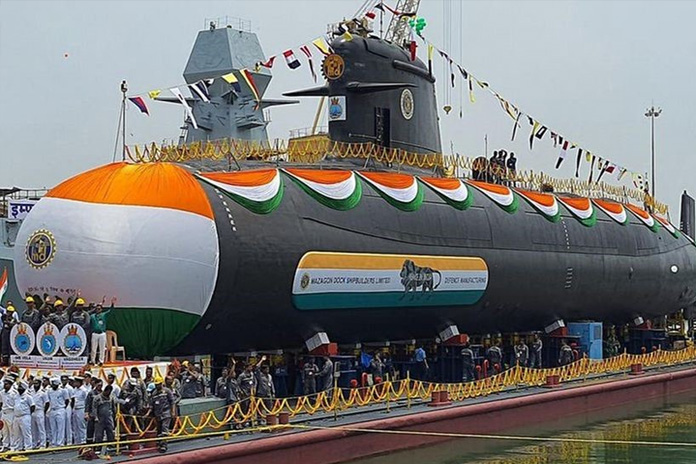India’s second nuclear submarine, the Arighaat, was commissioned into the Indian Navy on Thursday at Visakhapatnam. The submarine has undergone extensive trials over the last few months.
Defence Minister Rajnath Singh said at the commissioning ceremony that the Arihant-class submarine will “further strengthen India’s nuclear triad, enhance nuclear deterrence, help in establishing strategic balance and peace in the region, and play a decisive role in the security of the country”.
INS Arighaat
The 6,000-tonne INS Arighaat will join its predecessor, the nuclear submarine INS Arihant, as a key component of the India’s nuclear triad, which refers to a country’s ability to launch nuclear missiles from platforms in the air, land, and at sea.
India is part of a select group of countries with nuclear triad capabilities, which includes the United States, Russia, China, and France. The induction of INS Arihant into the Navy in 2016 provided India with maritime strike capability for the first time.
The commissioning of INS Arighaat will enhance the Navy’s nuclear strike capability. The nuclear-capable Agni 2, Agni 4, and Agni 5 missiles can be launched from land, and fighter aircraft of the Indian Air Force such as the Rafales, Su-30MKIs, and Mirage 2000s can deliver nuclear warheads.
The nuclear-propelled Arighaat will be armed with indigenously built K-15 missiles, with a range of more than 700 km. Like Arihant, Arighaat is powered by 83 MW pressurised light-water nuclear reactors, which allow it to remain submerged and undetected for much longer than conventional diesel-electric submarines.
Under its “No first-use” policy, India is committed to using nuclear weapons only for deterrence and retaliation. With its ability to survive a nuclear attack and then launch a retaliatory strike, a nuclear sub acts as a very strong deterrent.
The Arighaat is significantly more technologically advanced than the Arihant, the Ministry of Defence said in a statement. The construction of Arighaat involved advanced design and manufacturing technology, detailed research and development, utilisation of special materials, complex engineering, and highly skilled workmanship, the statement said.
“It has the distinction of having the indigenous systems and equipment which were conceptualised, designed, manufactured and integrated by Indian scientists, industry, and naval personnel,” it said.
INS Arihant
India’s nuclear-powered submarine project was initiated more than three decades ago, involving both private firms and the Defence Research & Development Organisation (DRDO), with help from Russia. Arihant was launched in 2009, and commissioned into the Navy in 2016 as its first nuclear-powered submarine.
INS Arihant conducted its first deterrence patrol in 2018, thus establishing India’s nuclear triad. In October 2022, the Ministry of Defence announced the successful launch, “with very high accuracy”, of a submarine launched ballistic missile (SLBM) in the Bay of Bengal by Arihant.
Indian Navy’s submarines
Two nuclear ballistic submarines (SSBNs) larger than Arihant and Arighaat, of around 7,000-tonne displacement, are currently being built. The first of these two subs is said to have been launched in 2021, and is awaiting commissioning pending trials and tests; the second is in the works as part of a separate classified project.
In comparison, the United States has 14 Ohio-class SSBNs and 53 fast-attack submarines. China has 12 nuclear submarines, of which six are nuclear-powered attack submarines.
The Indian Navy also has 16 conventional submarines in service — seven Kilo (Sindhughosh) class, four Shishumar class, and five French Scorpène (Kalvari) class attack submarines.
India procured the USSR-developed, diesel electric Kilo-class submarines from the mid-1980s onward. These boats have a lifespan of around 30 years, and can serve for somewhat longer after retrofitting with modern devices.
The Shishumar class submarines, developed by the German yard Howaldtswerke-Deutsche Werft (HDW) and subsequently built in India, were commissioned from the 1980s onward.
The Kalvari class submarines were built at India’s Mazagon Dock in partnership with France’s Naval Group. The first of these submarines, INS Kalvari, was commissioned in 2017, followed by several other vessels.
To carry out its full spectrum of operations, the Navy is authorised to have 18 submarines, a milestone that has been achieved with the commissioning of INS Arighaat. However, at any time, around 30 per cent of the fleet is under refit (repair and renovation), which brings down the strength of operational submarines.
The Navy has gone for medium refit and life certification, which includes all major repairs and replacements on a ship. This has been done to extend the lives of some of the ageing subs until the new boats come in.










